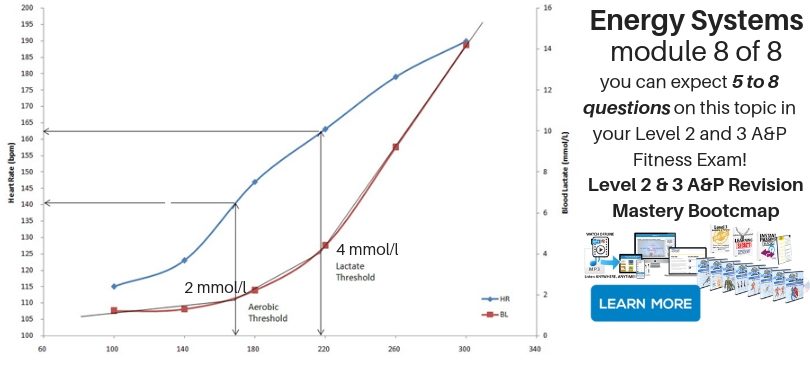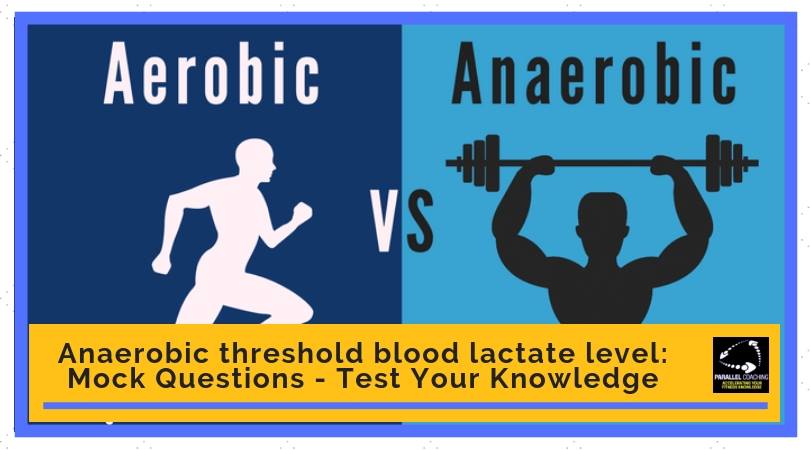As part of your Level 2 and Level 3 Anatomy and Physiology Exam, you will need to know about Anaerobic threshold blood lactate levels. This is usually found within the Energy Systems part of your anatomy exam, and you’ll also see it when learning about programming for your clients.
There are two key “thresholds” that you need to know about, and then you need to know how this relates to Blood lactate accumulation… so that’s exactly what I’m going to share with you in this blog:
- A Mock Question to test your current knowledge
- What is blood lactate?
- What is the Aerobic Threshold blood lactate level?
- What is the Anaerobic Threshold blood lactate level?
- More Mock Questions that you can download for free…
So, let’s do this…
What is blood lactate and how does it relate to Aerobic and Anaerobic Threshold:
🧐 Level 2 + 3 Anatomy & Physiology Mock Question 🧐
📣 Q: What is the approximate blood lactate level, in mmol, at the anaerobic threshold❓
👉a. 2
👉b. 4
👉c. 6
👉d. 8
What’s the CORRECT answer? Go…
The Correct Answer is B = 4mmol/l
Find out why, by reading the rest of the blog below…
What Is Blood Lactate, and Why Should You Care About It?
Lactate is a substance created by your muscles to fuel anaerobic (sugar-burning) metabolism. It’s actually a clever way for them to recycle the metabolic waste products that build up during exercise.
Most lactate gets burned by your muscles as fuel. But a small percentage of it leaks into your blood, where it can be detected by a blood test.
Blood lactate levels increase with exercise intensity, but the relationship isn’t linear. It’s more like a curve, and there are two points where the curve steepens.
As it turns out, these two “thresholds” correspond with changes in your breathing patterns. Both are very important markers that can help you exercise at the right level.

Aerobic threshold (AeT)
Aerobic threshold training (AeT) is performed at intensities between aerobic and anaerobic thresholds. These intensities are usually performed as long slow duration (LSD) training sessions. AeT training is the minimum intensity recommended to improve aerobic fitness and reduce disease (ASCM 2000/2014).
AeT training will see a rise in blood lactate levels above baseline (resting) levels to approx 2mmol/l.
When you reach this training intensity, heart rate (Hr) and breathing rate will be increased. Knowing the heart rate of our client that corresponds to their AeT can make or break your endurance training.
The following adaptions can be expected in training with the AeT.
- Increase in capillary density
- Increase in myoglobin
- Increase in the number and size of mitochondria
- Increased energy systems (ATP, glycogen, and FFAs)
- Increased ability to oxidise fat and spare glycogen
however, exclusive use of this type of training will probably not provide huge increases in aerobic sports performance. AeT training can be performed for any length of time from ten minutes to several hours. The duration of training in this zone will depend on the client’s fitness level, training age, and training goals. The specific intensity will depend on the duration of the training, i.e. the longer the session the lower the intensity within the aerobic zone.
Anaerobic threshold (AnT)
As exercise intensity and heart rate rise above the aerobic threshold, your blood lactate levels rise.
Acid is a byproduct of lactate creation. This also builds up in your blood causing your blood pH to rise. The build-up of lactate at this intensity is approx 4mmol/l. Fortunately, your blood contains substances that can combine with the acid to neutralize it (or “buffer” it). This buffering process creates excess carbon dioxide which must be exhaled through your lungs. This is why you breathe faster when you’re working above your aerobic threshold.
These buffers also react with lactate to create new substances that can be used by the body as fuel.
If exercise intensity/heart rate continues to increase, your body will start creating so much lactate and acid that your body can’t buffer them fast enough. Above this point, your blood lactate levels will increase exponentially with intensity.
This threshold (and the heart rate that corresponds to it) is known as the anaerobic threshold.
Other names you might here include lactate threshold, the onset of blood lactate accumulation (OBLA), or second ventilatory threshold (VT2). They’re all a little different but correspond to about the same exercise intensity and HR.
AnT training is a very specific type of training performed at exactly (or close as possible to) the anaerobic threshold. This type of training will maximize the aerobic benefits previously discussed as we as develop the client’s lactic acid tolerance and improve their ability to remove the waste products of anaerobic metabolism from the muscles.
Training at AnT is demanding and should only be undertaken by clients who have an appropriate level of training experience (training age) and physical conditioning.
Typically, AnT sessions last 20-40 minutes with the recommendation to use a heart rate monitor to aid control of intensity. Ideally, HR should not deviate much more than 2-3 bpm either side of the AnT heart rate. In conjunction with heart rate, RPE should be encouraged with the perceived rate of hard RPE 8 or RPE 13-15 on the Borg scale.
The main training response from this type of session is a shift to the right of the lactic acid curve. As a result of the AeT and AnT now occur at higher exercise intensities, indicating increased aerobic performance. For this reason, AnT is commonly regarded as the best performance predictor in endurance athletes.
In summary
- Blood lactate levels rise with exercise intensity and heart rate
- The Aerobic threshold is the intensity/HR where blood lactate levels begin to rise to 2mmol/l
- We can tolerate low blood lactate levels of 2mmol/l for quite some time
- The Anaerobic threshold is the intensity/HR where blood lactate levels begin to rise to 4mmol/l
- We cannot tolerate a high blood lactate level for very long. However, training can make you more tolerant to higher levels
Test your knowledge with three mock questions:
[NOTE: The answers are below the 3rd questions]
Q1:The Aerobic threshold is the intensity/HR where blood lactate levels begin to rise to what level?
A. 1mmol/l
B. 2mmol/l
C. 3mmo/l
D. 4mmo/l
Q2: Which threshold is characterised by lactate levels reaching 4mmol/L?
A. Aerobic Threshold
B. Antagonist Threshold
C. Anaerobic Threshold
D. Vo2Max
Q3: Which f the following is NOT a benefit of training in the aerobic threshold?
A. Increase in the number and size of mitochondria
B. Increase in capillary density
C. Decreased ability to oxidise fat and spare glycogen
D. Increase in myoglobin
Answers to the mock questions are :
Question 1= B, Question 2 = C, Question 3 = C
If you want more mock questions like this, then you can download more Free Mock Questions: DOWNLOAD NOW
Need More Help with your Level 3 Anatomy Revision?
For Trainee FITPROS Taking Their L3 Anatomy & Physiology Exam.
Learn, Revise & Pass Your Level 3 Anatomy & Physiology Exam In Under 10-hours
(Without Having To Spend Hours Revising Or Feeling Overwhelmed)
If you want to get your revision structured, learn everything you need to know, and feel confident on exam day, then click the link below:

Dedicated to More
Hayley “Anaerobic threshold blood lactate level” Bergman
Parallel Coaching
P.S. You can also find us on the following platforms:
Instagram: Follow Now
Facebook: Like Our Page
Twitter: Tweet Us
YouTube: Subscribe Here
More Energy Systems Blogs: HERE

